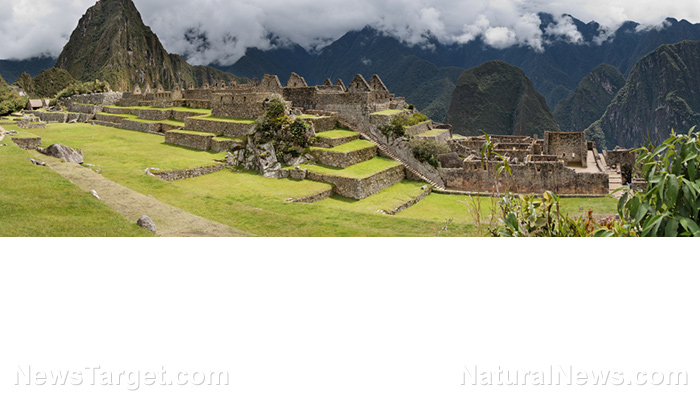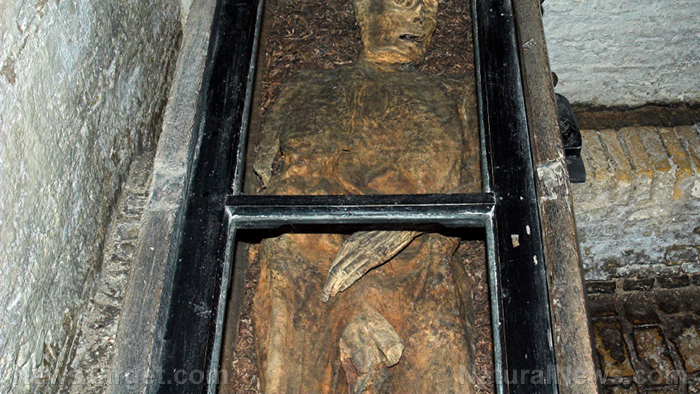Enigmatic "Gate of the Gods" in Peru revives debate over lost ancient civilization
By willowt // 2025-04-14
Tweet
Share
Copy

- The Gate of the Gods (Aramu Muru), carved into a red sandstone cliff in Peru’s Andes, is a T-shaped structure (23 ft tall, 22 ft wide) with a central niche. It was discovered in 1996 by José Luis Delgado Mamani, who claimed to have seen visions of a "sacred portal" with marble doors. Locals report supernatural phenomena, though scientific studies found no evidence.
- Andean folklore describes it as a portal to the spirit world, linked to an Inca priest (Aramu Muru) who allegedly vanished through it using a golden disc. The niche’s recess aligns with disc legends, but no physical proof exists. Some consider it a cursed "Devil’s Doorway."
- Mainstream scholars attribute it to the Tiwanaku civilization (200 BCE–1000 CE), known for advanced engineering. However, its differing carving style leaves dating uncertain.
- Archaeologist Dr. Khan suggests it reflects Tiwanaku’s ritual cosmology, blending architecture with spiritual symbolism.
- Shows like "Ancient Aliens" propose interdimensional travel theories, citing the structure’s precision and isolation. Theorists like Tsoukalos speculate the golden disc was a "technological device." No empirical evidence supports these claims, but they draw global intrigue.
The structure and its legends
Carved into a remote mountainside near Lake Titicaca, the Gate of the Gods (Aramu Muru) rises 23 feet tall and 22 feet wide, featuring a central niche (6.5 feet by 3 feet) flanked by vertical grooves. Discovered by local tour guide José Luis Delgado Mamani in 1996, the site gained notoriety through his claims of being guided by dreams of a sacred portal inhabited by “pink marble doors with figures.” Locals and travelers allege supernatural phenomena, such as strong energy fields, vibrations and visions, but scientific studies have found no electromagnetic anomalies. The structure is central to Andean oral traditions. Aymara and Quechua legends describe it as a “path to the spirit world,” where Inca priest Aramu Muru allegedly fled Spanish conquistadors in the 16th century, using a golden disc from Cusco’s Temple of the Sun to vanish into another dimension. Though the disc itself remains a myth, a recess in the niche aligns with descriptions of its placement.Theories compete: Ancient engineers vs. aliens?
Mainstream archaeologists attribute the Gate to the Tiwanaku civilization (200 BCE–1000 CE), which thrived near Lake Titicaca and pioneered monumental construction. Dr. Mohammad Firoz Khan, an independent archaeologist, notes the Tiwanaku’s engineering prowess, such as raised-field agriculture and hydraulic systems, could explain the structure’s precision, even without advanced tools. However, the carving style differs slightly from Tiwanaku’s typical designs, leaving uncertainty in dating. “Despite the lack of organic material for carbon dating, the Tiwanaku’s grand scale and innovation make them plausible builders,” said Dr. Khan in an X post. “This remains an enigma tied to ancient Andean cosmology — a place where the material and spiritual worlds intersected.” Conspiracy theorists and pseudohistorical programs like Ancient Aliens have pushed an extraterrestrial angle. Giorgio Tsoukalos, a frequent guest on the show, argued: “Something happened here. The disc might have been a technological device for interdimensional travel.” David Childress, another host, highlighted the structure’s oddity: “It’s a gateway to nowhere… carved into solid rock, and it’s literally in the middle of nowhere.”Historical context: Tiwanaku’s legacy
The Tiwanaku Empire, which preceded the Inca by centuries, dominated much of the Andes through innovation. Their mastery of agriculture on nutrient-rich raised fields, storage systems for surplus crops and complex urban planning extended their influence across 130,000 square miles. Their capital, near Lake Titicaca, rivaled contemporary cities globally and influenced later empires. “It’s no stretch to imagine Tiwanaku engineers creating such a site,” said Dr. Khan. “They had organizational capacity and ritualistic architectures that blurred the lines between human society and the divine.” The Gate’s placement near a ceremonial center and its alignment with nearby landmarks, including a cross-shaped map across Lake Titicaca, further suggests ritual or astronomical significance.Mysteries endure
Though legally protected as an archaeological site, the Gate lacks funding for modern excavations. Controversies linger over its purpose: a portal to another realm, a ritual space, or merely a misunderstood Tiwanaku monument. The Aymara long avoided the site, considering it a “Devil’s Doorway,” and some still conduct shamanic prayers there today. As debates rage, the site underscores broader trends in perceptions of pre-Columbian Americas. “These stories reflect a need to explain lost knowledge,” said archaeologist Alan Kolata, referencing pre-Hispanic advancements dismissed in colonial histories. “Whether ancient astronaut theories are valid or not, they attract attention to the sophistication of indigenous cultures.”Conclusion
The Gate of the Gods stands as a testament to the enduring mysteries shaping Andean history. While mainstream science seeks empirical answers, the site’s symbolism — uniting myth and archaeology — resonates in a world hungry for connections to the past. Whether it marks an interdimensional threshold or an overlooked Tiwanaku achievement, its allure endures, inviting thinkers, tourists and scholars alike to ponder humanity’s forgotten milestones. “As long as the Gate of the Gods remains unexplained, it embodies a dialogue between science and imagination,” said Dr. Khan. “Perhaps uncovering its secrets will force us to rethink what we define as ‘advanced’ civilizations.” For now, the mountains of Peru guard their secret, while the quest for truth continues. Sources include: DailyMail.com Ancient-code.com Medium.comTweet
Share
Copy
Tagged Under:
archaeology conspiracy ancient civilization artifacts Peru unexplained ancient astronauts discoveries cosmic real history Hidden History Inca Andes Mountains lost civilization indigenous cultures devil's doorway Tiwanaku Empire ancient mystery
You Might Also Like
Ancient mummies rewrite human history with “ghost” lineage discovery
By Willow Tohi // Share
U.S. moves to block Chinese control of Panama Canal, citing national security threat
By Cassie B. // Share
Recent News
Life expectancy in Gaza halved during first year of war, Lancet study finds
By isabelle // Share
Federal immigration officials to screen social media for antisemitism posts
By lauraharris // Share
Trump moves to cut federal funding for "death trap" sanctuary cities
By avagrace // Share
Trump imposes staggering 104% tariffs on all Chinese imports, escalating trade war
By lauraharris // Share











